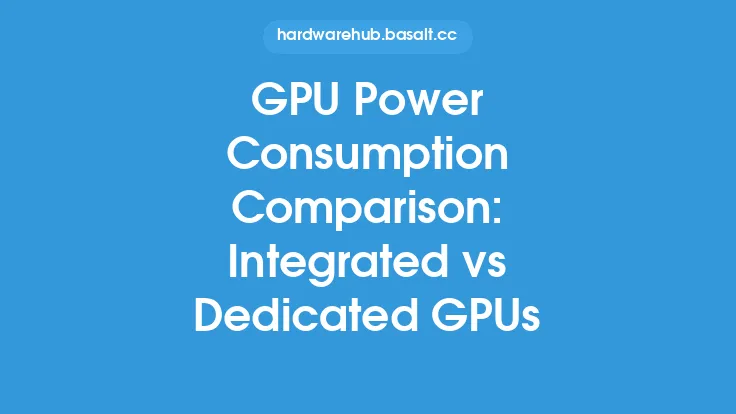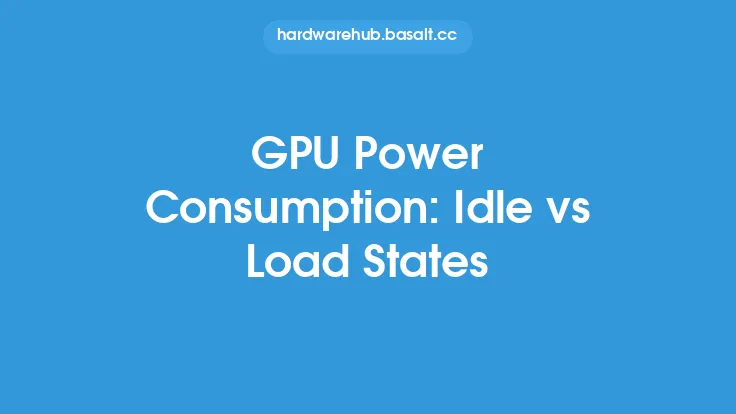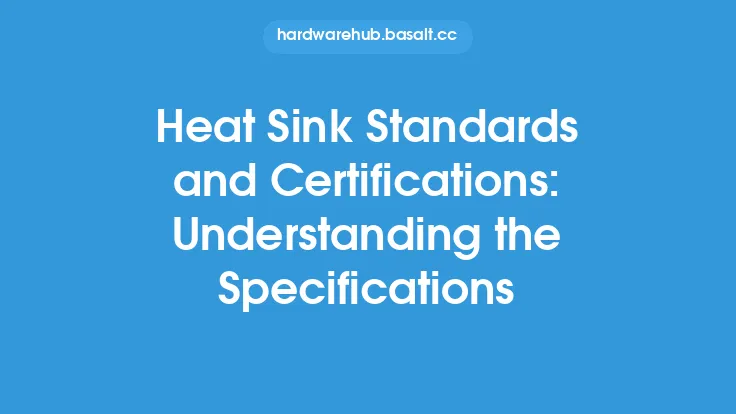The power consumption of Graphics Processing Units (GPUs) has become a critical factor in the design, development, and deployment of computer systems. As GPUs continue to play an increasingly important role in various applications, including gaming, scientific simulations, and artificial intelligence, the need for standardized power consumption measurements and certifications has grown. This article delves into the world of GPU power consumption standards and certifications, providing an in-depth explanation of the various protocols, organizations, and initiatives involved.
Introduction to GPU Power Consumption Standards
GPU power consumption standards are designed to provide a common framework for measuring and comparing the power consumption of different GPUs. These standards help ensure that GPUs are designed and manufactured with energy efficiency in mind, which is essential for reducing electricity costs, heat generation, and environmental impact. The development of these standards involves collaboration between industry leaders, research organizations, and regulatory bodies. One of the key standards is the Graphics Technology Consortium's (GTC) Power Management (PM) specification, which provides guidelines for GPU power management, including power states, voltage regulation, and clock speed control.
Certifications and Compliance
Several certifications and compliance programs have been established to ensure that GPUs meet specific power consumption standards. For example, the ENERGY STAR program, developed by the U.S. Environmental Protection Agency (EPA), certifies products that meet energy efficiency standards. To qualify for the ENERGY STAR label, GPUs must meet specific power consumption requirements, such as a maximum power consumption of 20 watts in idle mode. Another example is the 80 PLUS certification, which is awarded to power supplies that meet certain efficiency standards. While not exclusively focused on GPUs, the 80 PLUS certification is relevant to GPU power consumption, as it ensures that power supplies can deliver power efficiently to the GPU.
Industry Initiatives and Organizations
Several industry initiatives and organizations play a crucial role in promoting energy efficiency and standardizing power consumption measurements for GPUs. The Green Grid, a non-profit organization, focuses on advancing energy efficiency in data centers and promoting sustainable computing practices. The organization has developed several metrics and standards for measuring data center energy efficiency, including the Power Usage Effectiveness (PUE) metric, which can be applied to GPU-based systems. Another example is the Open Compute Project (OCP), which aims to promote open-source hardware designs and energy-efficient data center practices. The OCP has developed several specifications and standards for data center equipment, including GPUs, with a focus on energy efficiency and sustainability.
Technical Specifications and Protocols
Several technical specifications and protocols are used to measure and manage GPU power consumption. The Advanced Configuration and Power Interface (ACPI) specification, developed by Intel, Microsoft, and Toshiba, provides a framework for managing power consumption in computer systems, including GPUs. The ACPI specification defines several power states, including D0 (active), D1-D3 (standby), and D4 (off), which can be used to manage GPU power consumption. Another example is the PCI Express (PCIe) specification, which provides a high-speed interface for connecting GPUs to the system. The PCIe specification includes power management features, such as Active State Power Management (ASPM) and L1.2 link state, which can help reduce GPU power consumption.
Standardization Efforts and Future Directions
Standardization efforts are ongoing, with several organizations and initiatives working to develop new standards and certifications for GPU power consumption. The International Electrotechnical Commission (IEC) has developed several standards for measuring energy efficiency in computer systems, including the IEC 62087 standard, which provides a framework for measuring the energy efficiency of computer systems, including GPUs. The IEC is also working on new standards for measuring the energy efficiency of data centers, including the IEC 62702 standard, which will provide a framework for measuring data center energy efficiency, including the energy efficiency of GPUs. As the demand for energy-efficient computing continues to grow, it is likely that new standards and certifications will emerge, driving innovation and adoption of energy-efficient GPUs.
Conclusion
In conclusion, GPU power consumption standards and certifications play a critical role in promoting energy efficiency and reducing the environmental impact of computer systems. The various standards, certifications, and initiatives discussed in this article provide a framework for measuring and comparing GPU power consumption, driving innovation and adoption of energy-efficient GPUs. As the computing industry continues to evolve, it is essential to stay informed about the latest developments in GPU power consumption standards and certifications, ensuring that computer systems are designed and deployed with energy efficiency in mind. By understanding the technical specifications, protocols, and standardization efforts involved, individuals and organizations can make informed decisions about GPU selection, system design, and energy efficiency, ultimately contributing to a more sustainable computing future.





